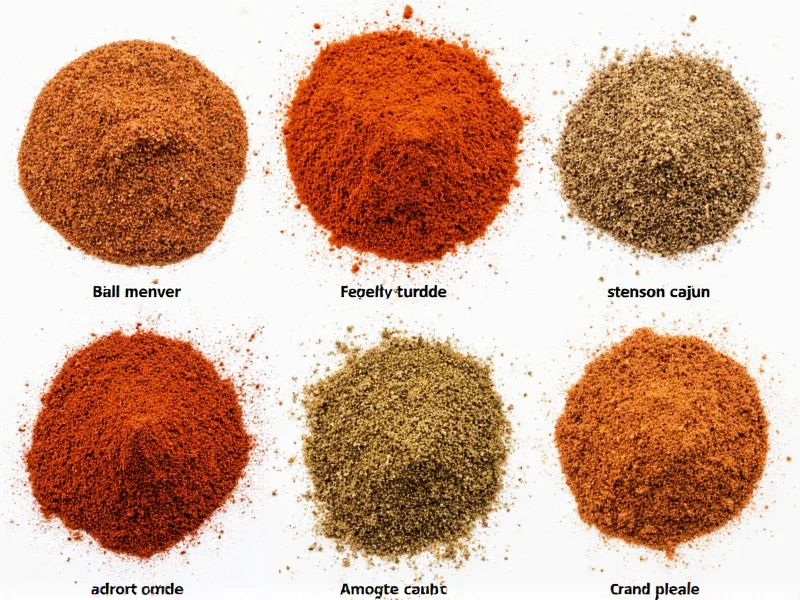If you're looking for a cajun seasoning alternative, the best immediate substitute is a 1:1 replacement with creole seasoning. For a homemade solution, combine 2 tablespoons paprika, 1 tablespoon garlic powder, 1 tablespoon onion powder, 1 teaspoon cayenne pepper, 1 teaspoon dried thyme, 1 teaspoon dried oregano, and 1 teaspoon black pepper. This blend captures the essential smoky, spicy, and herbal notes of traditional cajun seasoning without requiring specialty ingredients.
Understanding Cajun Seasoning's Unique Flavor Profile
Cajun seasoning is a cornerstone of Louisiana cooking, known for its complex blend of heat, earthiness, and aromatic herbs. Unlike many spice blends, authentic cajun seasoning contains no paprika as a primary ingredient—relying instead on cayenne for heat and smoked peppers for depth. The traditional blend features garlic, onion, black pepper, and regional herbs like filé powder (ground sassafras leaves). Modern commercial versions often include paprika for color and additional heat elements.
When seeking a cajun seasoning alternative, understanding these core components helps you make intelligent substitutions. The key is balancing heat (from cayenne or black pepper), earthiness (from garlic and onion), and herbal notes (thyme, oregano). Salt content varies significantly between brands, so check labels if you're monitoring sodium intake.
Top Cajun Seasoning Substitutes Ranked by Effectiveness
Not all alternatives work equally well in every recipe. Here's how common substitutes measure up for different cooking applications:
| Substitute | Best For | Limitations | Substitution Ratio |
|---|---|---|---|
| Creole seasoning | Seafood dishes, gumbos, jambalaya | Contains more herbs (oregano, thyme) | 1:1 replacement |
| Homemade blend (recipe below) | All applications | Requires multiple spice ingredients | 1:1 replacement |
| Blackened seasoning | Steaks, chicken, grilled foods | Less heat, more paprika-forward | Use 25% less |
| Old Bay seasoning | Seafood boils only | Completely different flavor profile | Use sparingly |
Creating Your Own Cajun Seasoning Alternative
When commercial blends aren't available, crafting your own cajun seasoning alternative ensures you control ingredients and intensity. This basic recipe works for most applications and can be modified for dietary needs:
Classic Homemade Cajun Blend
Ingredients:
- 2 tablespoons paprika (smoked preferred)
- 1 tablespoon garlic powder
- 1 tablespoon onion powder
- 1 teaspoon cayenne pepper (adjust to heat preference)
- 1 teaspoon dried thyme
- 1 teaspoon dried oregano
- 1 teaspoon freshly ground black pepper
- 1 teaspoon salt (optional)
Instructions: Combine all ingredients in a small bowl, whisking thoroughly to distribute evenly. Store in an airtight container away from light and heat. Properly stored, this blend maintains potency for 3-4 months.
Dietary Modifications
Salt-free version: Omit salt and add 1 teaspoon celery seed for depth. This salt-free cajun seasoning alternative works well for those monitoring sodium.
Milder version: Reduce cayenne to 1/4 teaspoon and add 1 teaspoon white pepper for complexity without intense heat—ideal for cajun seasoning alternative for beginners.
Smoky variation: Replace regular paprika with smoked paprika and add 1/2 teaspoon chipotle powder for authentic campfire notes.
Substitution Strategies for Specific Dishes
The best cajun spice blend alternatives vary by application. Understanding these nuances prevents flavor imbalances in your cooking:
For Seafood Dishes
When making shrimp étouffée or blackened fish, creole seasoning makes the most effective substitute for cajun seasoning in shrimp dishes. The additional herbs complement seafood beautifully. Use equal parts, but reduce added salt elsewhere in the recipe since creole seasoning typically contains more sodium.
For Heartier Meats
For jambalaya or grilled chicken, a blackened seasoning works better than creole. The paprika-forward profile creates that signature crust. When using blackened seasoning as your cajun seasoning alternative, use 25% less than the recipe calls for since it's typically saltier and more intensely spiced.
Emergency Substitutions
Out of multiple spices? Try these quick fixes:
- No paprika? Use 1 tablespoon chili powder plus 1/2 teaspoon cumin for color and depth in your cajun seasoning alternative without paprika
- No cayenne? Substitute 1/2 teaspoon red pepper flakes (finely crushed) plus extra black pepper
- Missing dried herbs? Double the garlic and onion powder, adding 1/2 teaspoon each
Avoiding Common Substitution Mistakes
Many home cooks make these errors when seeking a cajun seasoning alternative:
Overcompensating for Heat
Cajun food isn't necessarily about extreme heat. Traditional cajun seasoning uses black pepper as the primary heat source, with cayenne for accent. When substituting, start with less heat and adjust during cooking. You can always add more spice, but you can't remove it.
Misunderstanding Regional Differences
Many confuse cajun and creole seasonings. Cajun (from rural Acadiana) is spicier with more black pepper, while creole (from New Orleans) features more herbs. When choosing your creole seasoning vs cajun seasoning substitute, consider which regional flavor profile better suits your dish.
Ignoring Freshness Factors
Ground spices lose potency quickly. For the most accurate easy cajun seasoning alternative recipe, use spices purchased within the last 6 months. Test older spices by rubbing a small amount between your fingers—if the aroma is weak, replace them before making your blend.
Storing and Using Your Alternative Blend
Proper storage maintains your homemade cajun seasoning alternative quality. Keep it in an airtight container away from light and heat sources. Glass jars with tight-sealing lids work better than plastic containers, which can absorb odors.
When using your substitute in recipes, add it early in the cooking process for dried blends to allow flavors to bloom. For delicate dishes like seafood, add half during cooking and the remainder just before serving to preserve volatile aromatic compounds.











 浙公网安备
33010002000092号
浙公网安备
33010002000092号 浙B2-20120091-4
浙B2-20120091-4